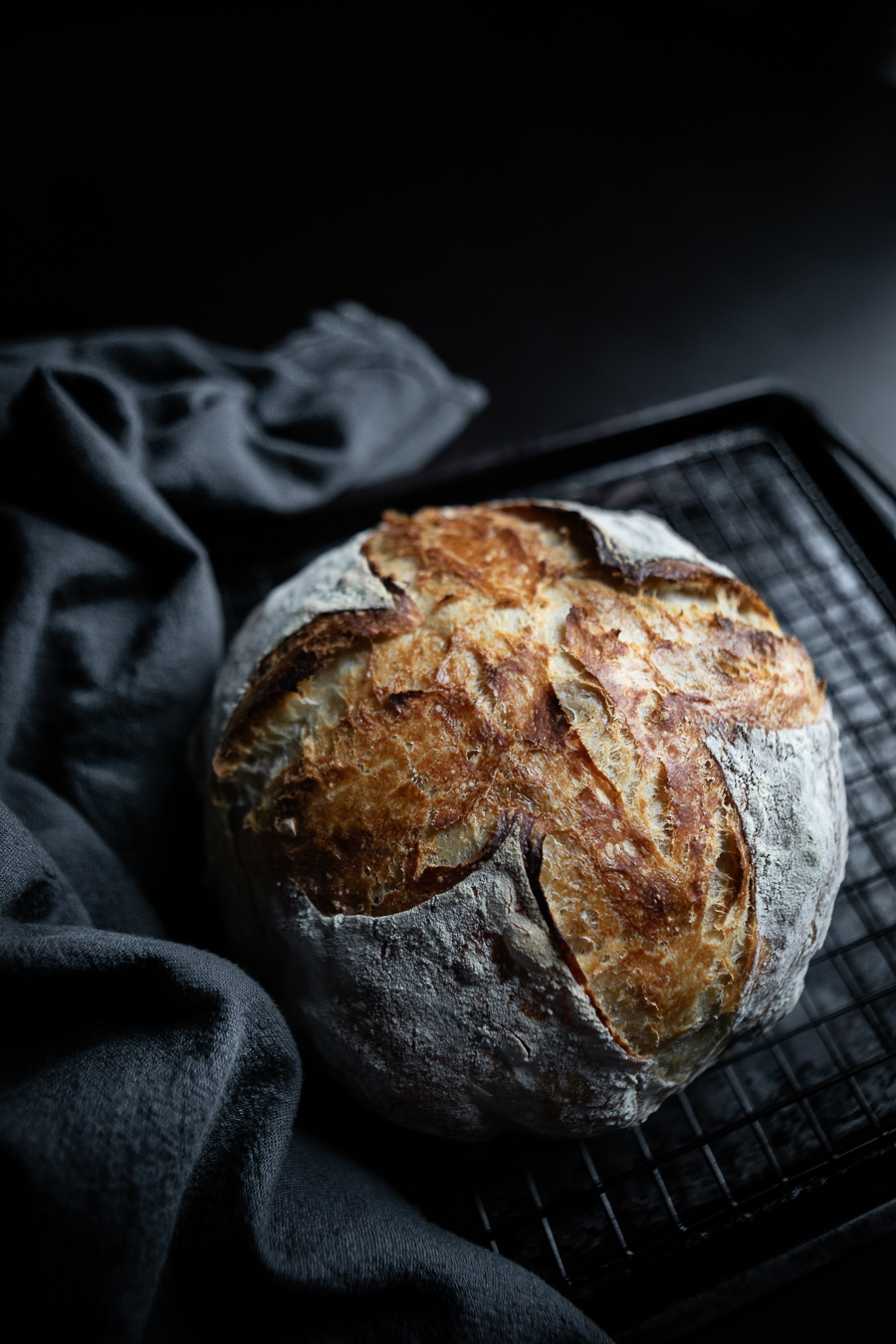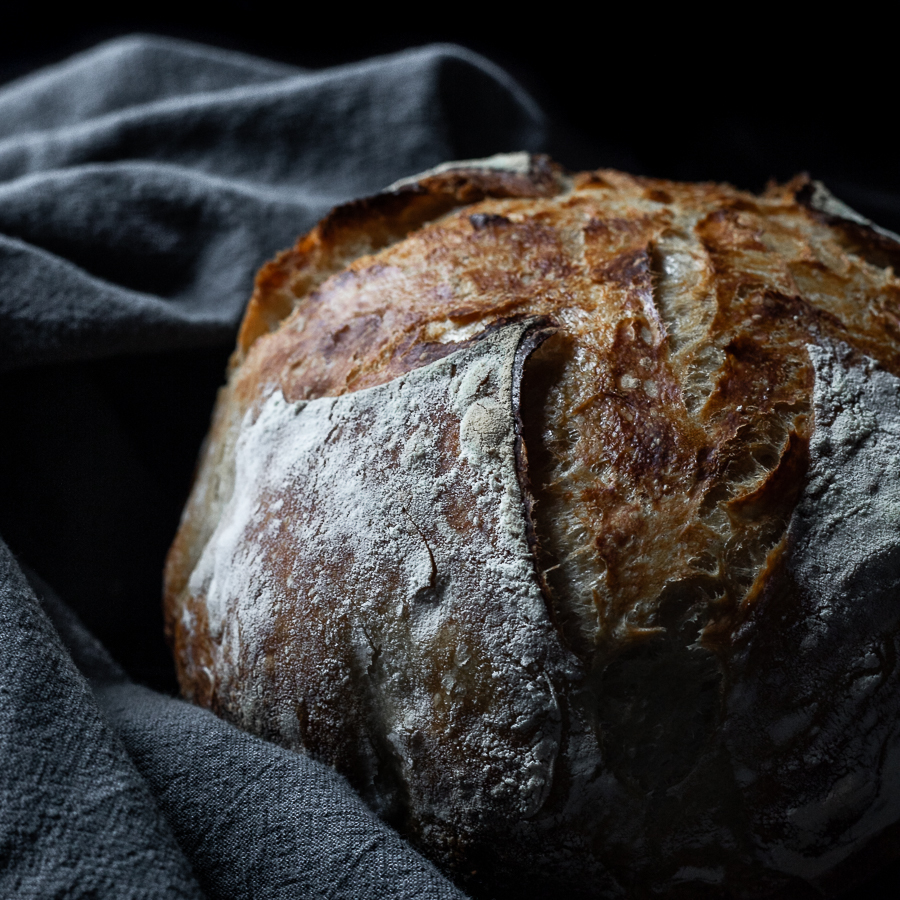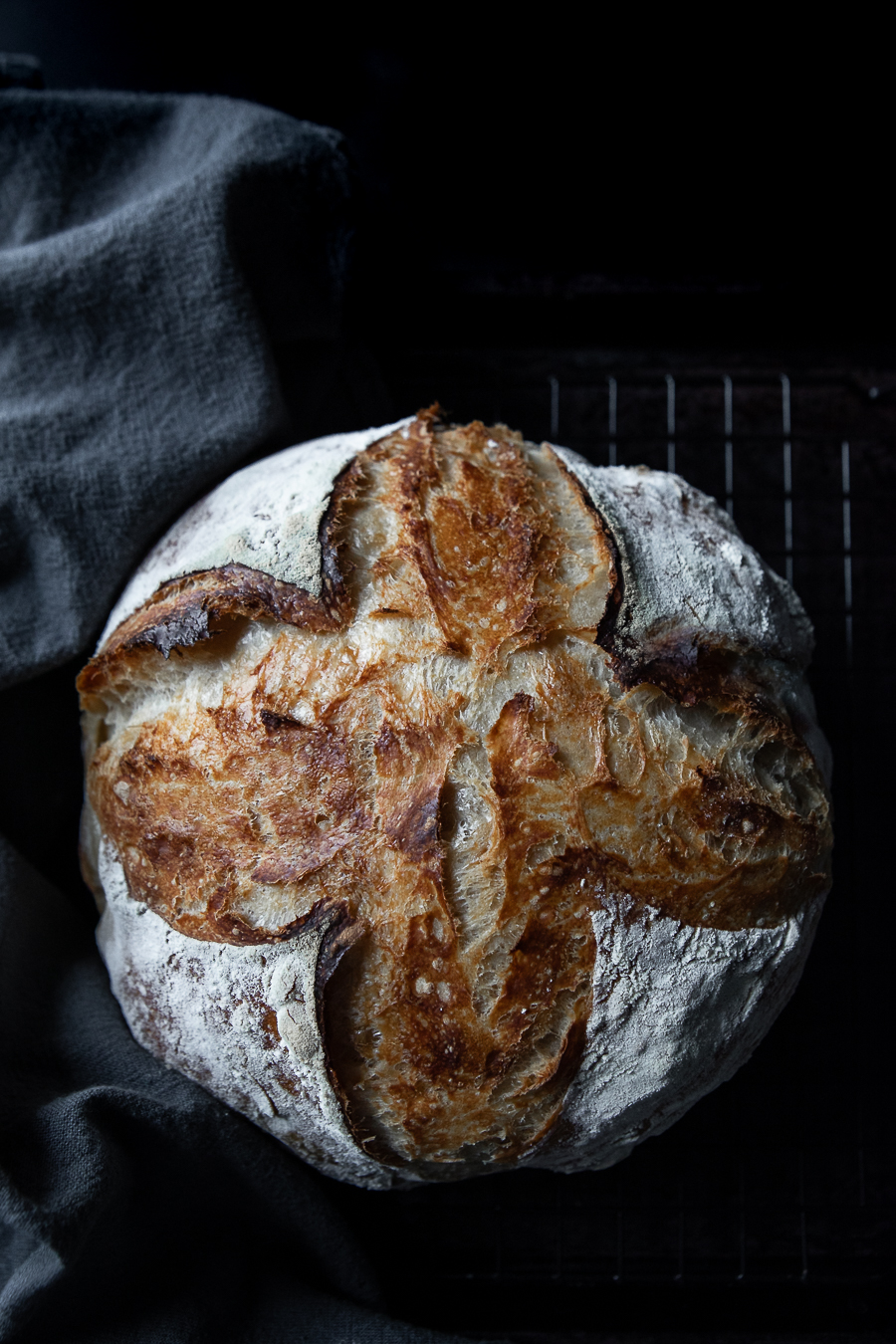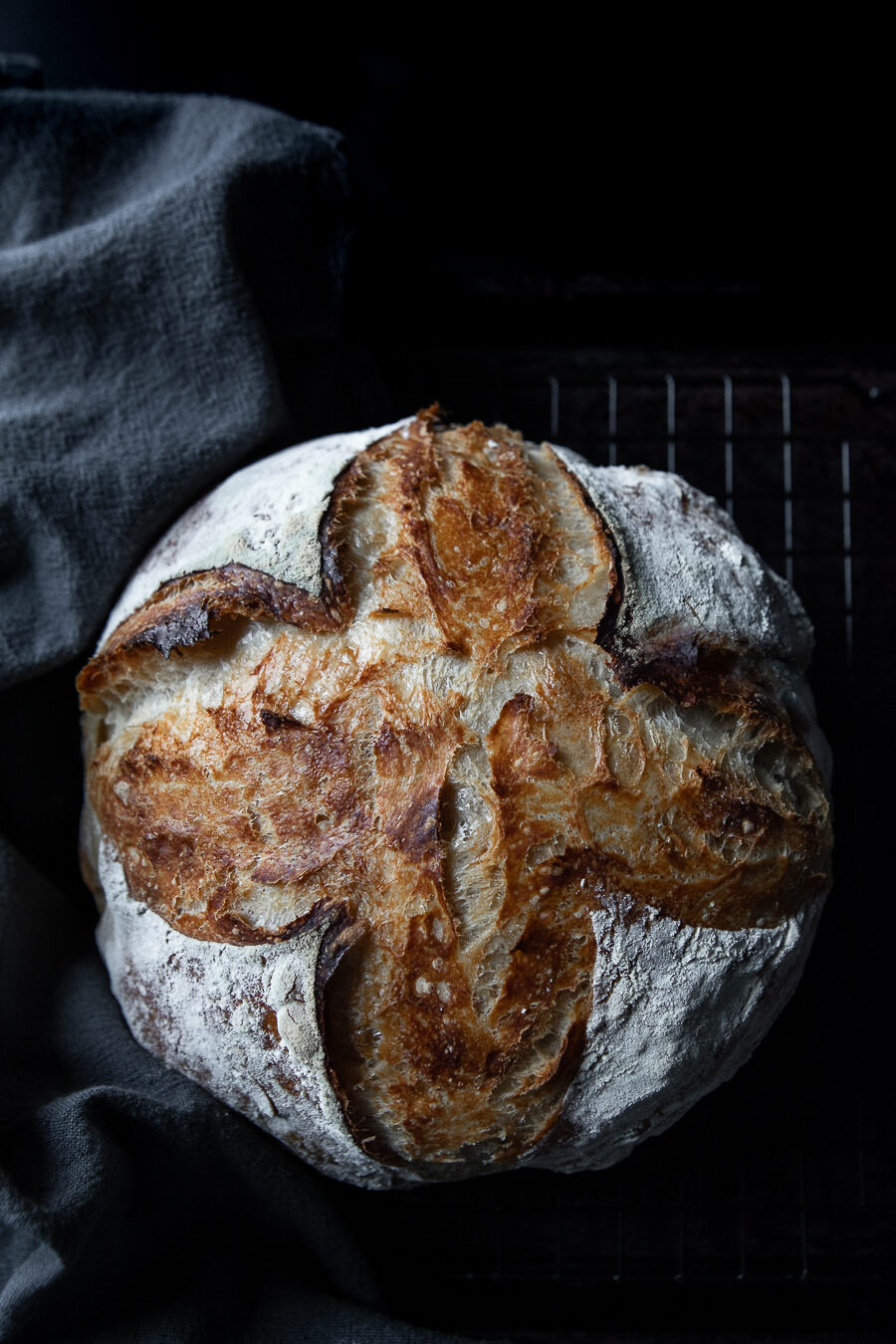Prepare the dough at night, bake it in the morning.
The rise happens while you’re sleeping.
“The beauty of sourdough bread is that no two loaves are ever exactly the same.”
Light and airy with a dark, crispy crust, a crumb with a creamy texture and a superb mouthfeel – this simple, overnight sourdough bread recipe might be the only one you’ll ever need.
Whether you have an established sourdough starter – or a new, younger one – this is an easy and simple sourdough bread recipe, especially helpful if you’re a beginner. We’re not using starter when it’s active and at its peak. Instead, we’re going to use a very hungry starter – one that was last fed 12 hours earlier.
There are no days spent waiting and shaping. All the shaping happens right in the bowl. Two sets of stretch and folds in the evening, then while you sleep – the bulk fermentation (rise) happens. In the morning, you’ll perform two sets of folds, again all inside the bowl. The dough will rest in the refrigerator while the Dutch oven heats up to a scorching level, and then you’re ready to bake. That’s it.

Sourdough Starter
First things first, you’ll need an established and strong sourdough starter. Even if its’s a new one – so long as you’ve been feeding it and it’s been tripling – yes, tripling, at least – I’m in the camp that once you’ve reached that point, and it’s been consistent, go make yourself some bread.
As an aside, I was struggling for a long time to get my sourdough starter going – it took me a little over two months. So don’t be discouraged if you’re reading this and still struggling with your starter. You’ll come across a lot of resources that will say it should only take 7-14 days. That’s probably true, most of the time – but, not always. It can take months, even if that is the exception. It will depend on so many factors: the environment, the temperature, the ratio. So, don’t give up – and don’t start over (unless you see signs of mold), just keep discarding and feeding, you’ll get there.
I was feeding our starter an equal ratio of 1:1:1 (starter, organic flour, filtered water) like everything I read said to do. It would volumize, there would be some bubbles, but it never doubled. I bought a heat wrap (since I started this in autumn and our counters are cold) and made sure the jar had a small towel underneath to keep the bottom warm. Still, nothing. Then I read somewhere to double the flour and “almost double” the water – and that’s what worked for me.
With a 1:2:1.3 ratio our starter not only doubled, it’s been consistently quadrupling. No idea why our starter responded to that and nothing else, but I’ve stuck with it. In traditional form, we’ve named our starter. She’s Sara Dough – because… it sounds like sourdough… :). But we just call her Sara.

In any event, while I was waiting for something, anything, to happen with my starter, I began to research beginner sourdough recipes. I wanted something I could easily incorporate into our busy school and sports schedule. Sylvia, from at Feasting at Home, had a wonderful beginner’s recipe. That’s where I started, but I’ve made some adjustments along the way.
I’m sharing the version that has worked best for me, with you.
The Rise
You’ll have to see what works best in your environment. There are no rules here, rather a method based on judgment, technique, experience, and your personal environment.
As a collector of old, historical cookbooks, I began to thumb through the pages to see if there were any tips for heirloom breadmaking that could help me now. Remember, the task of making wild yeast and homemade bread was the only way bread was made for thousands of years. Here’s an excerpt to remind you that this journey, no matter the era, is unique and personal:
“It is more difficult to give rules for breadmaking than for anything else; it depends so much on judgment and experience. In summer, bread should be mixed with cold water; during a chilly, damp spell, the water should be slightly warm; in severe cold weather, it should be mixed quite warm, and set in a warm place during the night. If your yeast is new and lively, a small quantity will make the bread rise; if it is old and heavy, it will take more. In these things I believe wisdom must be gained by a few mistakes.” The American Frugal Housewife, 1833
What works for me is to feed my starter in the morning, let it rise and fall, and about 12 hours later, when it is time for another feeding, I prepare the dough for our daily bread. The bulk fermentation happens overnight in my turned-off oven with the ambient light on, as my kitchen and counters can be quite cold during the night. Through trial and error, I’ve found that an 8-9 hour rise is when my dough is ready.
By the time 7:00 a.m. rolls around, I begin my morning folds. I take my children to school, and come back to bake it. We’ve had fresh homemade sourdough bread everyday now for months. Even on busy sports days, when we need to leave the house by 9:00 a.m., our bread is done and cooling on the counter until we come home. While there’s recipes for lamination, and days worth of shaping and waiting, you won’t find that with this easy and simple recipe. My family looks forward to this loaf everyday. My daughter’s friends ask me for it – telling me that it’s the best bread they’ve ever had in their life. So it’s safe to say that my heart is full – and this recipe is easy – that’s enough for me to be quite content.
The Crumb
You’ll certainly get a gorgeous crumb, with different sized air bubbles, some big and interesting, some not so much. You will not get the kind of open crumb that will make all the contents of your sandwich fall out. I love an open crumb, too – I know it’s the holy grail for a lot of sourdough bread bakers, but there’s a time and place for everything. A widely open crumb is perfect for serving alongside soup, or with charcuterie. It’s not an everyday bread for most families with children and teens. My children love butter and chocolate on their bread after school (a French thing), or cheese and chocolate (an Italian thing) depending on the day, and they want the contents of what’s on their bread to stay there.
Technique Videos
#1 – The Night Before you Bake: Stretch & Fold
- After the dough comes together in a cohesive, shaggy mass, you will let it rest for 15 minutes covered with a damp towel.
- Then, with a bowl of water nearby and a clean, wet hand, you will perform a set of stretch and folds until the dough begins to resist. Wetting your hand as needed.
- Cover the bowl again with a damp towel and rest for 15 minutes.
- You’ll perform one more set of stretch and folds the exact same way, flipping it over in the bowl once it begins to resist.
- Cover with a damp towel and keep somewhere warm. If you have a warm kitchen, the counter will do. Otherwise, place the bowl in a turned-off oven with the ambient light on.
Below is a video to demonstrate the night before you bake stretch and fold.
#2 – The Morning of the Bake: Fold-overs (a varied coil fold)
In the morning, after you’ve uncovered the dough and checked to see if it almost doubled in size, has bubbles on the surface, and perform a poke test (gently poke a slightly wet finger into the surface to see if the indent gently springs back) – you will perform two sets of loose folds, sort of like a coil fold, but keeping the dough loose and airy, trying not to make it tight.
- Keeping a bowl of water nearby to wet your clean hands, you will gently loosen the dough from the perimeter of the bowl.
- With wet hands, you will reach under the belly of the dough and pull it straight up, folding it over onto itself. Do this about 2-3 more times before rotating the bowl to fold the other end under once.
- Quarter turn the bowl to gently fold twice in the other direction. Cover the bowl with a damp towel for 15 minutes.
- Perform another set of folds the same way, except when you quarter turn the bowl you will fold and lift the dough out and into the prepared banneton or parchment-lined bowl.
NOTE: Keep a bowl of water nearby to wet your hands as needed. These folds are simply techniques to help strengthen the gluten network, which is important. But, you do not have to be exact or precise – you also need to take into account your specific dough, does it feel quite loose and would benefit from an additional fold? Is it tight and two sets are sufficient? You need to use your judgment.
Below is a video to demonstrate the morning bake foldovers.
Join the Conversation!
If you’ve made this recipe, let me know! Leave a comment below, I’d love to hear from you. Don’t forget to tag a photo @chasingtheseasons on Instagram, I’d love to see.
“There’s no aroma in the world quite like the smell of a fresh sourdough loaf baking in the oven.”

Equipment
- 1 Dutch oven, round 5-7 quart
- parchment paper
- banneton, or bowl of similar size
- blade or baker's lame, for scoring or a sharp and oiled small knife
Ingredients
- 90 g sourdough starter (not active) use a starter that was last fed 10-12 hours earlier
- 385-390 g fresh filtered water, room temperature, or slightly warm
- 520 g bread flour organic
- 2 tsp fine sea salt
Instructions
About 8-12 hours before you want to bake:
- It's important to use a digital scale to make sure all the measurements are accurate.
- Add a large mixing bowl to a digital scale and clear the weight (use the "tare" function) so it weighs zero. Measure out the sourdough starter. Tare the scale again to zero, and measure out the water. Remove the bowl from the scale.
- Using a Dutch whisk, or something similar, mix the starter and water until it is milky and frothy and the starter is well combined.
- Add the bowl back to the scale. Tare the weight to zero again. Add the flour.
- Remove the bowl from the scale and add the salt. Using the same Dutch whisk gently combine the salt and flour before incorporating the liquid below the surface. Then, mix all the contents together until a shaggy and cohesive dough is formed. Note that the dough will be quite dry and hard to mix. Keep going, folding in the flour and pressing down, and mixing. It will come together in about a minute or two. If it doesn't come together at all, add the slightest amount of water and mix again.
- Cover the bowl with a damp towel and let it rest for 15 minutes.
- Keeping a small bowl of water nearby, wet your hand - and with one hand, do a set of stretch and folds. Picking up the dough from underneath and bringing it up and into the middle. Quarter turn the bowl and keep going until the dough starts to resist. I let the dough roll off the pads of my fingers so as not to tear. (see video technique #1).
- Cover the bowl and wait 15 minutes.
- Complete another set of stretch and folds in the exact same way. When the dough starts to resist, turn it over in the bowl. Cover the bowl with the damp towel again (so it doesn't dry out overnight), and place it in the oven TURNED OFF with just the oven light on. If your kitchen is warm, keep it covered on the counter, or if you have another warm area you prefer, use that.
- Next will be a little trial and error to find out how long your dough needs to bulk ferment (rise)*. For me, it is ready at 9 hours, but will depend on many factors unique to your home and bread, plan on anywhere from 8-12 hours. (See notes to determine when it's ready).
When the dough is ready to bake:
- Prepare a banneton or a large bowl with parchment paper, dust the bottom with flour. Set aside.
- Uncover the dough bowl. The dough should be somewhat rounded, volumized, with visible bubbles. Do the poke test (see notes).
- With slightly wet hands, gently help unstick the dough from the sides of the bowl. Slide your hands down the sides of the bowl
- Gently reach under the center of the dough and lift it up and fold it down on to itself to preform a set of folds. Quarter turn the bowl and repeat. (see video technique #2).
- Cover for 15 minutes with the damp towel and repeat one more set of folds -except when you quarter turn the bowl you will fold it over once (or twice if your dough feels it would benefit from another fold) then gently lift the dough and fold it onto itself in the parchment lined bowl.
- Pinch the sides if any seams are visible and flour the surface. Place the bowl in the refrigerator. No need to cover.
- Preheat the oven to 500 F. Place the empty Dutch oven inside the oven while it is heating with the lid securely on. Let the Dutch oven heat for an hour.
- ** See notes below. If considering a layer of foil below the Dutch oven to prevent the bottom of your bread from burning, add it after the Dutch oven has pre-heated.
- Carefully remove the Dutch oven and take off the lid, it will be scorching hot. Take the dough bowl out of the refrigerator and score it (noting that a simple cross or slash works best on a wet dough as this).
- Pick up the dough by the sides of the parchment paper and gently place it (parchment and dough) into the Dutch oven, taking care as it is extremely hot. A little bit of paper overhang is fine. Slightly open the scores a bit more if you prefer or put the Dutch oven lid back on and place it back into the hot oven.
- Bake at 500 F. for 25 minutes.
- Remove the lid. Reduce the heat to 450 F. and bake for another 25 minutes with the lid off.
- Carefully remove the bread (noting that any charred parts of parchment will easily rip). Remove and discard the parchment and allow the bread to rest on a cooling rack for 2 hours.***
Notes
Adapted from Feasting at Home
© chasingtheseasons. All images & content are copyright protected. Please do not use my photography without prior written permission. If you would like to republish this recipe, please re-write the recipe in your own words, or kindly link back to this post for the recipe.





One comment on “Sourdough Bread for Beginners”